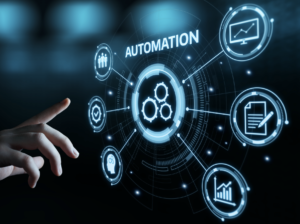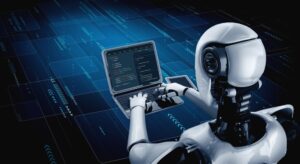
Hyperautomation’s Benefits and Challenges and How To Use It In Your Enterprise

(Alexander Limbach/Shutterstock)
Hyperautomation is a business-driven mindset by which organizations identify, prioritize, and implement automated business processes at a rapid pace using advanced technology. The design always involves the use of multiple technologies, tools, platforms, and package solutions that include process/task mining, artificial intelligence, machine learning, robotic process automation (RPA), business process management (BPM), intelligent document processing (IDP), content services platforms (CSP), integration platform as a service (iPaaS), application monitoring and observability, and other low-code/no-code automation tools. These automation technologies and tools are often layered on top of older systems (e.g. ECM, ERP, CRM) that are core to operations but lack extensible modern low code capabilities to advance automation in the company.
Hyperautomation is a rapid approach to intelligent automation that is key to an organization’s digital transformation strategy. By combining the use of modern low code / no code automation tools, enterprises can achieve quicker business outcomes and address business challenges that were often difficult to solve without months of planning and implementation. With the use of tools like RPA and cloud integration service platforms, connectivity between applications (both cloud and legacy systems) can be achieved with less time and a high ROI. Furthermore, the use of AI, machine learning, and pre-trained document understanding models are being leveraged today to automate the processing of unstructured data trapped in documents, conversations, and messages. These processes often include direct customer touch experiences where high value customer experiences are created, streamlining operations and winning customers in terms of business and retention. This can drive a better ‘Total Experience’ for both the customer and the company employee.
Today, new enterprise companies are disrupting traditional industry markets like banking and insurance. These companies can react quickly to changes in the market because of less legacy processes and systems and access to low code / no code automation opportunities when it comes to the use of AI and machine learning. Enterprises who are held back by complex business processes tied to legacy systems may struggle to digitally transform and will benefit tremendously by taking advantage of RPA, IDP, and other automation tools.
There are multiple technologies, tools, platforms, and package solutions that are used today as part of a hyperautomation design and approach, starting with process/task mining to first understand the existing processes so that the business impact to change can be measured. The technologies always include artificial intelligence, machine learning, and robotic process automation (RPA), , business process management (BPM), intelligent document processing (IDP), integration platform as a service (iPaaS), application monitoring and observability, and other low-code/no-code automation tools.
These technologies and tools are much more accessible to the broader automation teams given the low code / no code methodology and the pre-trained ML models that are available today. All these technologies get layered into more traditional business process management (BPM), and leverage integration platforms in the cloud as well. Given many processes span multiple systems involving automated bots, event driven activities, and humans-in-the-loop, it is essential that organizations utilize application monitoring and observability tools that can provide oversight of the processes, applications, bots, and human interactions.
There are several challenges and drawbacks to the use of some tools. For example, robotic process automation (RPA) is great at automating repetitive tasks that humans would otherwise perform but fall short when it involves unstructured data or many variances in a process. Furthermore, enterprises have struggled with the management and oversight of large bot deployments involving thousands of bots interacting with hundreds of systems and touching sensitive customer data. Oversight and security around the use of automated bots has often been a drawback to enterprises being able to scale the use of RPA.
While enterprises apply the methodology of hyperautomation to achieve quicker outcomes and automate everything they can, leaders should take the time to discover and understand the process and data behind it before assuming what tool or technology will be used. In some cases, RPA is a better fit and in other cases an iPaaS platform is better equipped to handle high volume transactional data. Furthermore, as traditional enterprise applications catch up and add new AI functionality, business and technical leaders will need to decide if the new capabilities are adequate or whether specialized automation tools fill the need and should continue to be leveraged.
Technology automation leaders who are seeking new approaches through emerging technologies should work closely with the business groups and leaders to first discover and identify the processes and business outcomes that the business wants to achieve. In some cases, the business problem being solved requires less invasive changes to the process; in other cases, the discovery and understanding of the problems turns into a bigger transformation initiative.
Common use cases for hyperautomation are found in front, middle and back-office processes, and often touch the customer experience as is the case with customer onboarding, order taking / processing, payments, returns, updates to customer data – all of which can be highly manual, involve unstructured data from documents, conversations (chatbots), and emails, and touch many backend systems.
Given the toolbox of specialized low code / no code automation options and wide use of AI and ML models with traditional enterprise applications, the one area that seems to get overlooked is the use of application monitoring for operational oversight, security, and alerts. An intelligent automation technology stack should ensure proper monitoring is in place that can capture complete application and process audit trails from log files, track bot creation and human activities, and monitor changes in processes and AI models. Additionally, specialized automation tools can pose risks to companies handling sensitive customer data given these tools often act on the data, move data between systems and loop humans into the process. Therefore, proper monitoring, oversight and alerts to operations, IT, and the business are necessary to consider as part of the business driven hyperautomation approach.
About the author: Brian DeWyer is CTO and Co-Founder of Reveille Software. With more than 25 years of experience in technology, Brian DeWyer provides product strategy and technical leadership in his role as Reveille CTO and board member. Brian leverages his extensive knowledge from his tenure as a senior IT leader at Wachovia and previous role as a process consulting practice leader for IBM Global Services delivering on-premises and cloud-based solution implementations for Fortune 1000 commercial and government clients. He has led process change efforts within large organizations, building on content-driven solutions for high-volume transaction processing applications. He is a past board member of the Association of Image and Information Management (AIIM) industry association. Brian graduated from Virginia Tech with a BSME and holds an MBA from Wake Forest University.
technology, Brian DeWyer provides product strategy and technical leadership in his role as Reveille CTO and board member. Brian leverages his extensive knowledge from his tenure as a senior IT leader at Wachovia and previous role as a process consulting practice leader for IBM Global Services delivering on-premises and cloud-based solution implementations for Fortune 1000 commercial and government clients. He has led process change efforts within large organizations, building on content-driven solutions for high-volume transaction processing applications. He is a past board member of the Association of Image and Information Management (AIIM) industry association. Brian graduated from Virginia Tech with a BSME and holds an MBA from Wake Forest University.
Related Items:
Paving the Way to Success in AI and Intelligent Process Automation
3 Ways to Boost Productivity with Hyperautomation
How to Be a Better Data Scientist in the Era of Automation and AI
































